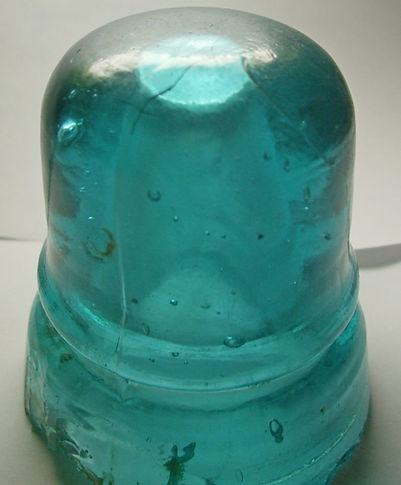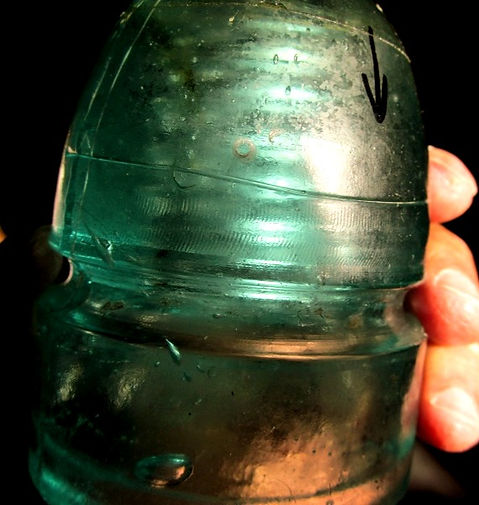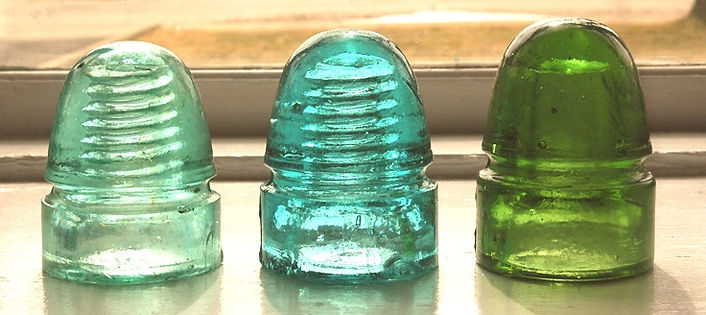BEE HIVE SHAPED INSULATORS :
THE BEGINNINGS
These will be mostly threadless moulds later used as threaded moulds by changing the pin .
ORIGINS AND CHANGES
To come to any idea of the origin of these requires a long term search of the history of the different glass works in Canada at the time frame of each.
"THEORY" ... DIFFERENT AMOUNTS OF GLASS MAKE THE SKIRT LONGER.
It has been said that different amounts of glass put into the mould made for a longer or shorter skirt. This is not possible in the 743.3 pair of moulds . While it might be possible in the 743.1 pair of moulds and the 743.2 mould , I find that from all I see it is not likely .
743.1 MOULDS
There are two pins and at least two base plates, so to compare the skirt height can only be done with all of the variables the same.
One other factor in my thought process is that by the time these bee hive threadless were converted to threaded in 1877, the Montreal Telegraph CD 143 was being made as a shorter skirt piece. Insulators sold for pennies each so a reduction in glass used would have increased profit by about 30% .
In comparing pictures of as many as I can find of each of the moulds , all of the threadless have equal or longer skirts when the base plate and pin are the same. I also find many of the short skirt insulators have a pin hole that goes very close to the dome , this would be an improper adjustment on the press for the downward stop .
The pic's below are from a friends collection taken several years ago. They were not chosen to support my thoughts but do so in each mould.
In each mould the threadless ones have a longer skirt than the threaded ones. Note also even in the threaded ones the shorter the skirt the closer the pin is to the top of the dome. This is because as the skirt was shortened the stop for the press was not adjusted. These along with dozens of pic's I have from many sources leaves me certain that the more glass idea is not correct. I leave this open to further info from others, but for myself I do not accept the "more glass" idea.



TIME LINE
While others have dated these with various beginning and end dates ( 1865-1870 for threadless & 1870- 1885 for the threaded versions.) I find those dates to be incorrect.
The threaded patent was in effect till 1877.
Hamilton Glass Co. made the McMicking threadless dated 1875 for delivery in 1876. I find the first threaded insulator in Canada was the CD 143 Montreal Telegraph Co. in 1876 ( they may have paid to use the patent for one year or not) Each will be dated in the write up.
Through the mid 1870's the no embossing 742 supplied many of the smaller telegraph companies and railroads with insulators. Dominion Telegraph Co though needed a supply they were sure of . Burlington Glass was not in existence but Hamilton was . It though was making small insulators at that time eg. CD 734 , 734.5 and the 734.8 . As the evidence shows the 743.1 as a Burlington product it stands that Hamilton can be ruled out. Explained later.
THREADLESS MOULD CD's... 1st - 743.2 , second 743.1 , and 3rd 743.3
FIRST MOULD .. CD 743.2 THREADLESS
The first mould for this style of a threadless insulator was the CD 743.2 aka Cannon Ball. There is as far as I can tell only one mould . The pic below is my favorite , it is a lilac lavender with a slight purple tint.


NOTE .. While I try to only put forward factual info in these posts , on this mould there is only circumstantial thoughts that bring this together .
THE ST. LAWRENCE GLASS CO. - CONNECTION
I feel quite sure that the first ever Bee Hive shaped insulator was produced at St. Lawrence Glass Co. in 1872 . It was an advanced glass house in pressing lamps etc. In the historical article (Hudson) section of this site I wrote of the D.T.Co. CD 742 being a short lived product of the Canada Glass Co. Ltd. at Hudson Quebec 1871. Where did D.T.Co. go after that . It is my belief they went to St. Lawrence Glass Co. in Montreal , and this CD 743.2 was the insulator they used.
The St Lawrence Glass Co . closed in 1873 , their sheriff's auction was on July 10th 1873 . It is accepted by glass researchers that Burlington Glass Co. purchased much of the moulds etc from the St. Lawrence Glass co.
Also in the historical article section of this site on Canada Glass Co. Ltd. at Hudson Quebec I show the link between the St. Lawrence Glass Co. and Lamplough & Campbell Co. who took over the Canada Glass Co. Ltd , this is important because there are some no embossing CD 742's that have the tapered pin style of the 743.2 . It though is not the same , the top of the pin hole for the 743.2 is concave with a spike in the center , the top is 7/8ths of an inch and the bottom is 1 & 1/8th inches , the sides of the pin hole are bowed out .
Thanks to a friend for the measurements of the CD 742 tapered pin , it has a flat top , no spike and is about 5/8ths of an inch at the top and 1 inch at the bottom of the pin hole and the sides of the hole haqve a veryb slightly bowed taper.
I believe this was the Canada Glass Co. Ltd. at Hudson Quebec under Lamplough & Campbell about 1874 making a copy of the idea of a tapered pin . It though didn't sell well as there are few around. The problem is that it didn't fit the same wooden pin as the 743.2 or the standard straight wooden pin of regular threadless.
Below pic is of 742 with odd pin

NEXT STEP - BURLINGTON GLASS
In the fall of 1874 Burlington Glass Co. began making glass. I believe that the CD 743.2 was used there till about 1875 as a threadless. It's pin is used in the CD 743.1 insulators at that time.
CD 743.2 .. AS A THREADED ..
Later I feel the CD 743.2 was brought back as a threaded in 1877. The CD 743.1 filled the time from 1875 to 1877 as a threadless. It also became a threaded.
Pictures are above with threadless 743.2
SECOND MOULD PAIR .. CD 743.1
BURLINGTON GLASS
The next pair of threadless made were the CD 743.1 about 1875 .These have an odd flange at the top of the wire groove. The Burlington designation becomes clear in the write up of these insulators
Because there are a limited number for me to look at it is difficult to fully clarify these insulators. There has been no co-operative sharing where many pieces are brought together to examine yet I feel I have most of the ones needed to post the info.
It has been suggested that one mould was made from a rework of the other mould . That is not possible as it would have to have been that the smaller one was turned out to become the larger one. While that part is possible , why would the small one go through the threadless phase into the threaded phase 1877 to 1879 , only to be machined out as a larger one and revert back to a threadless use well after 1877 into the threaded era.
THE MOULDS
These two moulds are easy to tell from each other. I compare the domes to the ends of an egg, one with a pointy dome and the other as a rounded dome. They used the 743.2 pin , it was altered twice as noted below. They also had a rounded base and a tapered grooved base and a tapered base, that were used at different times as the base plate was altered.
Pics below are top rounder dome very small flange and below are pointier dome with larger flange.


BURLINGTON FEATURE
It is in the threaded insulators of these moulds that we find an odd feature that continues to the later days of the Burlington Glass . It is a fine pattern of lines that go around just above the wire groove. This was a roller that was used inside the mould on the lathe to harden the mould by compressing the iron at the wire groove so it would be less likely to chip. It can be found as late as the Round Base Canadian Pacific Ry. insulators. At this time it even is seen in the groove .
Pic on left side is of 743.1 threaded , on right is a round base Canadian Pacific Ry made at Burlington Glass .


ROUND DOME THREADLESS - 743.1
This one began life as a threadless with the large pin of the 743.2 which was 7/8ths of an inch top and the bottom is 1 & 1/8th inches. The pin now has been cleaned to make it 15/16ths at the top and1&1/16th at the bottom It had a rounded base . Note that the top of the later pin is larger so it is either a new pin or it was shortened a bit to where the pin is a little larger diameter with the same concave top and spike. Later it had the former pin but it had been turned to clean it making it 13/16ths top and 1& 1/8th inches at the bottom. It also had the round base and the tapered grooved base.
Below is pic of 2 different pin types used on these. Below are the Round Domes.
_edited.jpg)

ROUND DOME THREADED
Now with a threaded pin it had a tapered grooved base and may have come with the round base ( any input and pic's would help.) I have the pointy dome in this set with a tapered base without the groove so that also is a possibillity.
See Note on Burlington feature
Pic of this style is shown above.
POINTY DOME THREADLESS
The notes on the above round dome moulds seem to apply to this as well.
POINTY DOME THREADED
The notes on the above round dome moulds seem to apply to this as well.
See Note on Burlington feature. I don't have one with the feature on this one, I don't believe it was used on this mould.
Below is pic of Pointy Dome threadless and threaded.

THIRD MOULD PAIR .. CD 743.3
HAMILTON GLASS WORKS
There are two moulds in this group. A round dome and a square dome.
It is in this group that the idea of more glass in each insulator makes for a different height of insulator is shown to be false. This was a flawed idea in these moulds from the start. Yet people won't let that idea go. The base plate can never go farther down the tapered skirt that it's own diameter. It can, with an over press back off but that leaves a squirt of glass that goes above the skirt. That is because if the base plate is 2 3/4 inches and it rises then at that point the mould part that forms the skirt is slightly larger. This is shown in the pictures.
The different height is accounted for in alterations of the base plate or an over press. There are 3 or 4 reworks in each of the two moulds.
Pics below are. Top -two Square Dome of different heights , Base plate is altered.
Bottom pic shows an over press where glass squirted between base plate and skirt mould.


The pics below show alterations of the base plate . Top is original , note how base plate extends down into the mould skirt
Second pic shows smooth base phase. Note how base plate goes less into the mould making the skirt longer.
Third pic shows beveled base . Base plate goes only slightly less than the last rework with slightly longer skirt.



MOULD #1 SQUARE DOME
The original insulators from the mould had a rounded base with a slight taper. The pin was 15/16ths top and 1 1/16th inches bottom.
FIRST RE-WORK. Changes the base plate , and the threadless pin remains the same. The base plate is machined to remove chipping on it's outer edge. This gives a slight taper.
SECOND RE-WORK. It comes with a single threaded pin. The base plate is agian changed giving it an almost flat base but with a slight taper.
THIRD RE-WORK. The base remains the same as the previous rework. It has a double threaded pin .This is instead of a single thread which is a continuous spiral of one thread , the double threaded pin has two independent threads intertwined like a the stripes on a barbers pole.
Below are the single thread on left and double thread on right.

FOURTH RE-WORK.
I don't have one of these but find the square dome in it's last stage comes as a double thread with a short skirt . I don't have a pic of the base of this one, but the other mould (round dome ) has a odd base much like the continuous drip base type. I will have a pic of the round dome with this base style .
The shortest skirt I have is like an under pour . It has the Burlington feature , it is a double threaded piece I am sure this one was made after 1885 when Hamilton bought out Burlington. It is the shortest of my square dome ones putting it in that time frame.
Top left pic is a short skirt from under pour. Top right pic shows total under pour base.
Bottom right pic shows Burlington feature on a Hamilton made piece 1885 +



MOULD #2 ROUND DOME.
I don't have a threadless in this mould so can't give a certain detail on them . The single and double thread on these went through a few changes that alter the skirt height like mould #1.
Pic below are single threads at different heights. Below that is a double thread.


I do not have , and have not seen a tapered base in this mould , instead it has a couple of reworks that have a fairly flat base at first on the single thread, and a rounded base with a slight taper on the double thread.
The final use of this mould is a very short double thread that has what is called a continuous drip base.
Below pic is a longer skirt single thread beside it is the short skirt with a continuous drip base.
NOTE black ink circle showing a couple of dots caused by flaws in original mould on round dome mould. the short skirt in photo does not have these dots as the mould was machined out slightly.
Bottom pic shows continuous drip base of short.


THREADED HEAVY BEE HIVE .
This piece never comes as a threadless insulator. It starts as a single thread ( Very hard to find ) and very soon becomes a double thread.
The single thread comes with a slightly rounded base that is fairly straight across.
It is soon changed to a tapered base . This makes ( as in the mould # 1 of the above group ) a longer skirt.
Still later the base plate is again machined , while keeping the tapered base it again makes the skirt longer than the previous rework.
Pic below is single thread left and double thread on right. Note black ink on top right hand side on dome where there is a bump from a flaw in the mould.
